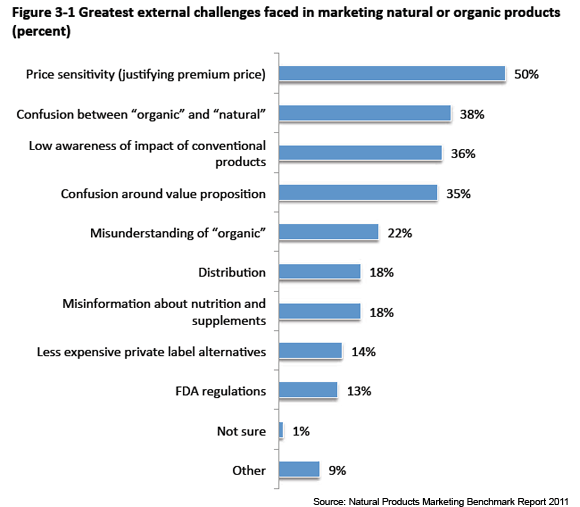|
One of the biggest challenges facing natural products companies, according to the Natural Products Marketing Benchmark Report 2011, is the perceived confusion in the market – confusion between organic and natural, misunderstanding of what is organic, misinformation about the products and confusion around the value proposition. With all of the confusion in the market it should not be surprising that 50% of respondents said that price sensitivity is one of their greatest external marketing challenges, and by that they meant justifying their price.
There is not much a single company can do about the confusion between organic and natural or about the misunderstanding of organic. As a marketing consultant for the natural products industry, I have observed that this confusion comes from the self-interest of multiple companies promoting definitions which happen to support their products. What you can do is control your company’s value proposition. What is a Value Proposition At its most basic, a value proposition is where you prove the value of your product in relation to its cost and benefits. It tells you why someone should buy your product or service. It helps differentiate your offerings from the competition, and it makes a compelling argument for why consumers should care. You can find many examples of value propositions on the web. Just go to the paid ads on the right hand column of Google and click on them. Many of these will go to a specific landing page which will attempt to give you their value proposition as quickly as possible. “Vitamin C on steroids.” “Guaranteed lowest price on Echinacea” “Most Potent Goji.” These are short term value propositions designed to convert the consumer into a paying customer. For long term results, however, natural products companies need to define their primary and secondary value propositions, and then make sure that all marketing supports them. Outline for Creating a Value Proposition Before you create your value proposition you need to conduct some preliminary research. 1. Competitive Analysis This entails first determining who your competition is. That should not be limited to companies that make the same products as you but rather it should be broadened to include those companies that provide the same wellness benefits as you do. If your super fruit is an excellent resource for Vitamin C, then you compete not only with other super fruit companies, but also with every other company that offers a Vitamin C alternative. Once you have your list then go on their websites and try to determine what their value propositions are and whether they succeed in differentiating themselves from other companies. You need to know what others are saying about themselves so when it comes time to craft your value proposition, you can see how it’s different and better than your competition’s. 2. Keyword Analysis Let’s face it, most people do their research on the web. So what is it that gets them to your website? What are the words that get the best results? Determining and analyzing the top keywords will tell you more about how people are finding you and what words they use. If you aren’t familiar with how to do this, there are many reputable SEO companies that can help. This will have a double benefit for you. It will help you with your value proposition and with your organic search. 3. Customer Analysis Try to categorize your customers through segmentation and also try to find out why they use your product. If you can interview a cross section of your current customers and ask them why they chose your products, what their main reasons were for doing so and what advantages they perceive about your product compared to your competition. 4. Prospect Analysis This is similar to the customer analysis except that you are dealing with those who have visited your website but have not purchased or those who buy your competition’s products. Once you have conducted this preliminary research you are ready to start developing your value proposition. 5. Key Messaging Based on the information gathered in your research develop a list of key messaging bullets. At first come up with the benefits as you perceive them. It could be how you grow your ingredients or what groups your products support or the efficacy of your product. Then take this list and see how these bullets match up with what your competition is saying, what your customers and prospects expect, and what people look for when searching for your product’s solution. 6. Value Propositions From the key messaging bullets and your analysis of how they match up with your research, start crafting 3-5 primary value propositions. Once these are done, compare them once again with the research. Choose 1-3 primary ones and 1-3 secondary ones. 7. Test your Value Propositions There are many ways you can test your value propositions – focus groups, interviews, alternate landing pages from pay per click ads, internal conversations. But in the end, it is how comfortable you are in promoting your value propositions, because once you commit to them, they will become the essential support for the branding of your products and your company. Comments are closed.
|
AuthorArchives
June 2011
Categories
All
|
|
Pioneer Communications Group is a marketing firm that specializes in helping small businesses that want to engage with their customers and prospects effectively, and profitably. We are expert in marketing strategy, communications, market research, marketing automation, and content creation. © 2016-Pioneer Communications Group
|


 RSS Feed
RSS Feed